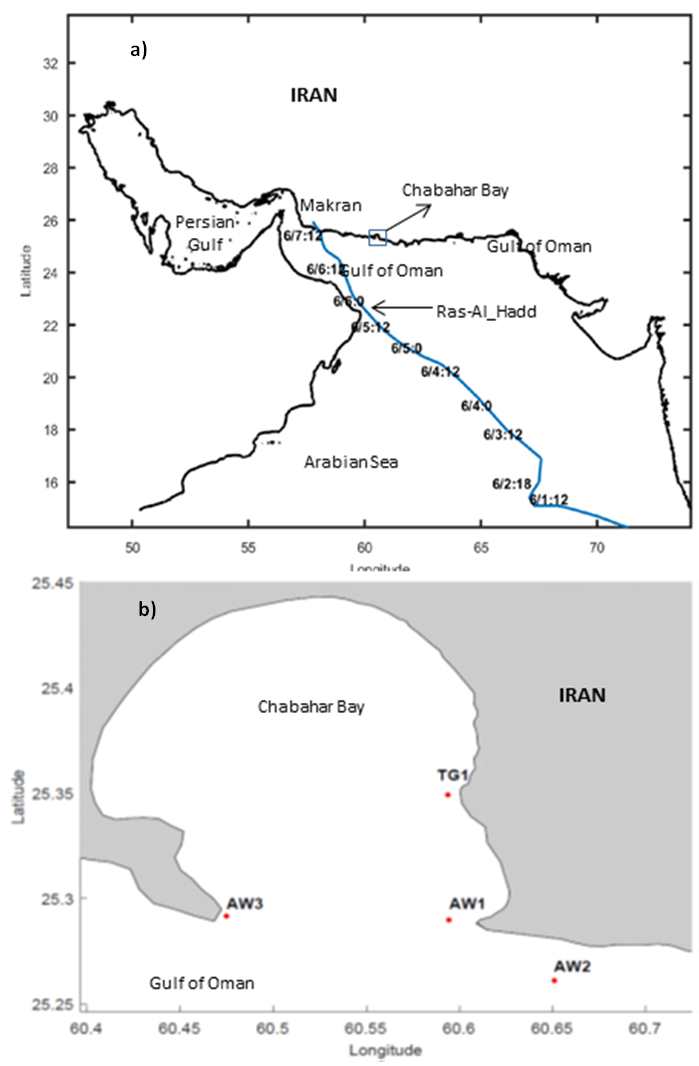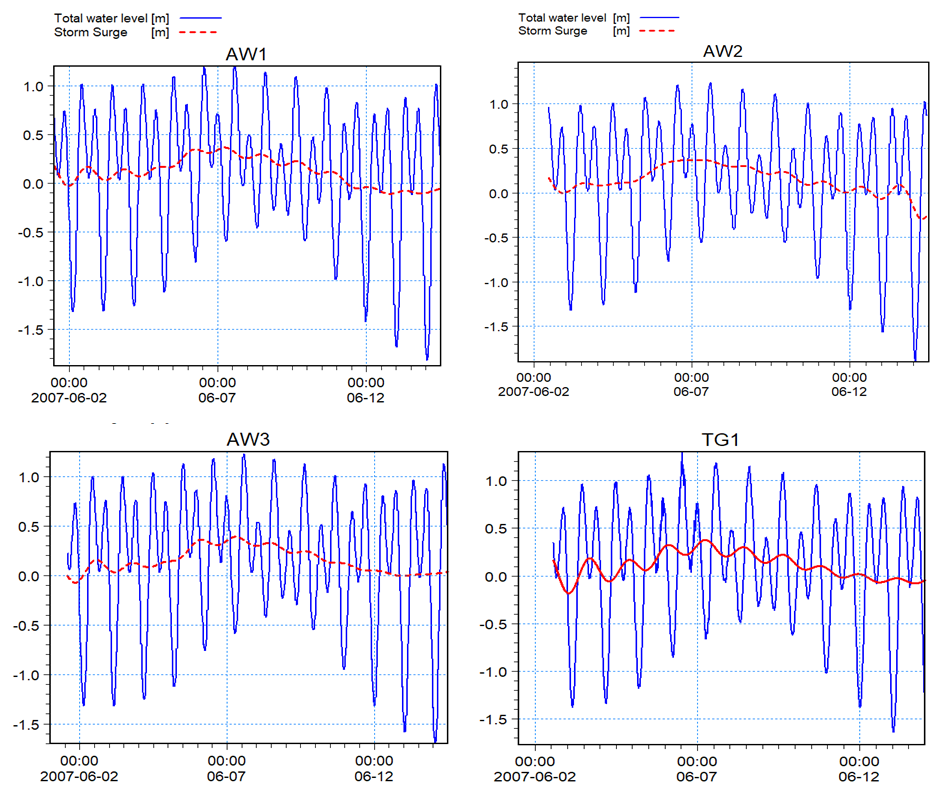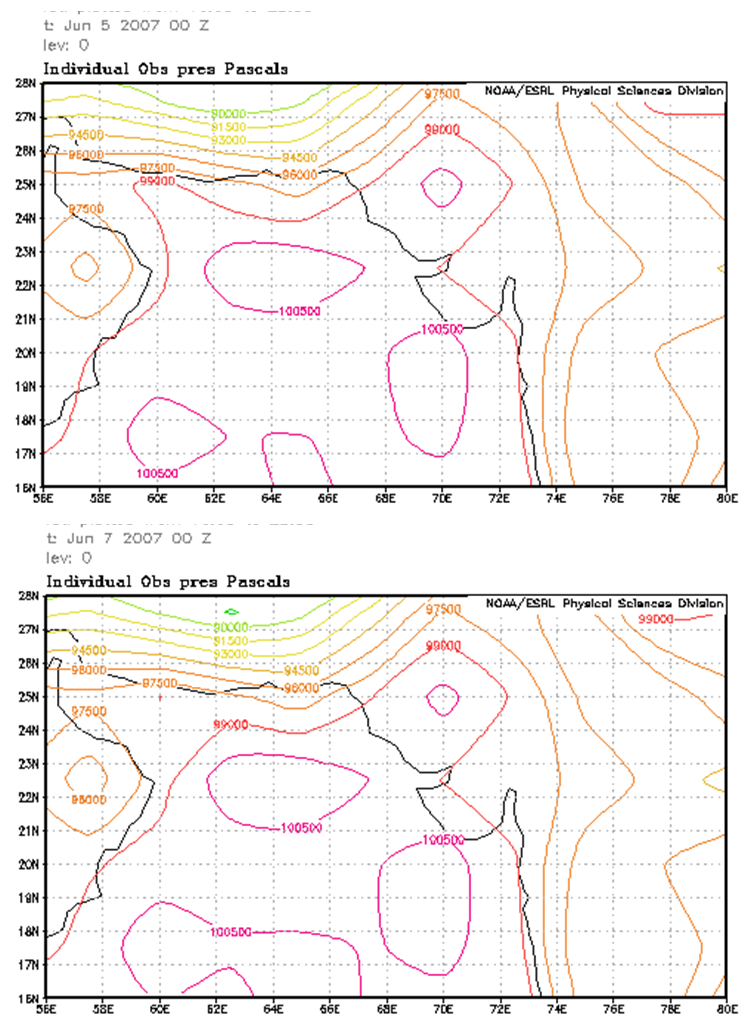-
Paper Information
- Next Paper
- Previous Paper
- Paper Submission
-
Journal Information
- About This Journal
- Editorial Board
- Current Issue
- Archive
- Author Guidelines
- Contact Us
American Journal of Fluid Dynamics
p-ISSN: 2168-4707 e-ISSN: 2168-4715
2018; 8(1): 10-18
doi:10.5923/j.ajfd.20180801.02

Cyclone-generated Storm Surge in the Northern Gulf of Oman: A Field Data Analysis during Cyclone Gonu
Mohammad Nabi Allahdadi1, Nazanin Chaichitehrani2, Felix Jose3, Ali Nasrollahi4, Amin Afshar4, Mohammadreza Allahyar5
1Department of Marine, Earth and Atmospheric Sciences, North Carolina State University, Raleigh, NC, USA
2College of the Coasts and Environment, Louisiana State University, Baton Rouge, LA, USA
3Department of Marine and Ecological Sciences, Florida Gulf Coast University, Fort Meyers, FL, USA
4Marine Engineering Group, N.F.T Company, Tehran, Iran
5Port and Maritime Organization, Tehran, Iran
Correspondence to: Mohammad Nabi Allahdadi, Department of Marine, Earth and Atmospheric Sciences, North Carolina State University, Raleigh, NC, USA.
| Email: |  |
Copyright © 2018 Scientific & Academic Publishing. All Rights Reserved.
This work is licensed under the Creative Commons Attribution International License (CC BY).
http://creativecommons.org/licenses/by/4.0/

Water level measurements at four stations from Chabahar Bay, Iran, have been analyzed to investigate the storm surge induced by Cyclone Gonu in June 2007. Water level data include semi-diurnal tidal variations and sub-tidal frequency variations induced by atmospheric forcing. A low-pass filter with a cut-off frequency of 30 hours was used to deduce the storm surge induced by Gonu from the total measured water level. Results show that at all four stations, a maximum water level rise of about 0.4 m was produced by the cyclone at the time that Gonu’s eye was in the Gulf of Oman closest to Chabahar Bay. Low atmospheric pressure and wind shear, major mechanisms for storm surge generation, were examined to determine the contribution from each to the observed water level rise. Pressure maps over the Gulf of Oman and northern Arabian Sea showed that more than 75% of the storm surge at Chabahar was produced by low atmospheric pressure and the rest was attributed to wind shear. This is consistent with the wind-induced surge calculation based on an analytical model suggested by Harris (1959). The large distance between the Gonu’s eye and Chabahar Bay, the steep shelf slope off Chabahar Bay, and the negative interaction between storm surge and coastally trapped waves could have contributed to the relatively small storm surge in Chabahar Bay.
Keywords: Storm surge, Cyclone, Gonu, Chabahar Bay, Gulf of Oman
Cite this paper: Mohammad Nabi Allahdadi, Nazanin Chaichitehrani, Felix Jose, Ali Nasrollahi, Amin Afshar, Mohammadreza Allahyar, Cyclone-generated Storm Surge in the Northern Gulf of Oman: A Field Data Analysis during Cyclone Gonu, American Journal of Fluid Dynamics, Vol. 8 No. 1, 2018, pp. 10-18. doi: 10.5923/j.ajfd.20180801.02.
Article Outline
1. Introduction
- Water level in coastal areas changes as a result of both short- and long-term processes. Long-term changes in water level is produced by global variations such as decadal anomalies and climate change ([1, 2]). Short-term variations include elevation changes induced by the periodic phenomenon of astronomical tides or by storm-induced variations. Catastrophic events like tropical storms significantly contribute to the hydrodynamics and water level variations of bays, estuaries, and coastal areas ([3-7]). Effect of tropical storms, including hurricanes, cyclones, and typhoons, on coastal water levels can be catastrophic and disastrous ([8-11]). Hurricane Katrina, which impacted the northern Gulf of Mexico in late August 2005, is an example for extreme hurricane storm surge and its devastating impacts. Due to the flat bathymetry of the shelf in the eastern Mississippi River Delta, the intense winds of this category 3 hurricane produced a storm surge of more than 9 m that destroyed the upstream coastal area and caused substantial loss of life and destruction of properties ([11]). Although cyclones frequently impact the northern Indian Ocean during the summer, they rarely enter the northern Arabian Sea and Gulf of Oman ([12-16]). Nevertheless, in early June 2007, the historic category 5 Cyclone Gonu traversed this area and caused loss of tens of lives and hundreds of millions of dollars in damages along the Oman and Iranian coasts (Figure 1; [12, 15]). The major part of these fatalities and damages were due to coastal flooding caused by the storm-induced surge ([12]). Understanding the mechanisms that contributed to the storm surge during cyclone events like Gonu in this region is imperative to minimize loss of life and destruction of coastal properties during cyclones in the future. Wave patterns generated by Gonu have been well studied and several numerical modeling studies have addressed wave patterns generated by Gonu in the northern Arabian Sea, Gulf of Oman, and Chabahar Bay in the northern Gulf of Oman ([15-17]). Storm surge produced by Cyclone Gonu, has not been well reported nor studied in a scientific manner. Fritz et al [12] analyzed data from high water mark surveys in the aftermath of Gonu along 270 km of the Oman coastline that was affected by the Cyclone. They reported that the highest water mark that included the combined effect of storm surge and storm wave was about 5 m and occurred at the tip of Oman at Ras Al Hadd. Simulation of Gonu’s induced storm surge using the Advanced Circulation (ADCIRC) model showed that due to the steep bathymetry of this area, only 1.5 meters of the water mark was attributed to storm surge and the rest was due to storm waves. No direct measurement of storm surge was used to address storm surge generation from Gonu.
2. Study Area and Field Data
- Water level was measured at the mouth and inside the Chabahar Bay as part of a modeling and monitoring project supported by the Iranian Port and Maritime Organization. The project included an extensive measurement of hydrodynamic parameters including water level, wave characteristics, and currents inside and outside Chabahar Bay. Water levels from four stations including AW1, AW2, AW3, and TG1 were used to deduce storm-induced water level variations (Figure 1b and Table 1).
|
3. Historical Cyclone Gonu
- Gonu is the strongest cyclone ever that has impacted the northern Arabian Sea and Gulf of Oman ([18]). On 1 June 2007, favorable upper level atmospheric conditions (i.e., small vertical wind shear) intensified the heat transfer from the warm sea surface to the atmosphere in the eastern Arabian Sea. As a result of this immense heat flux, by 5 June the pre-existing convection quickly developed into a cyclone as strong as a Category 5 hurricane, with a maximum sustained wind speed of 240 km/h ([18]). With a general northwestward track, the cyclone made its first landfall on the tip of Oman at Ras Al Hadd on 6 June (Figure 1). The final landfall was on the Makran coast of Iran about 150 kilometers east of the Persian Gulf ([18]). The satellite image of Gonu when its eye was located off the tip of Oman shows an extensive area over the northern Arabian Sea and Gulf of Omanis that was affected (Figure 2).
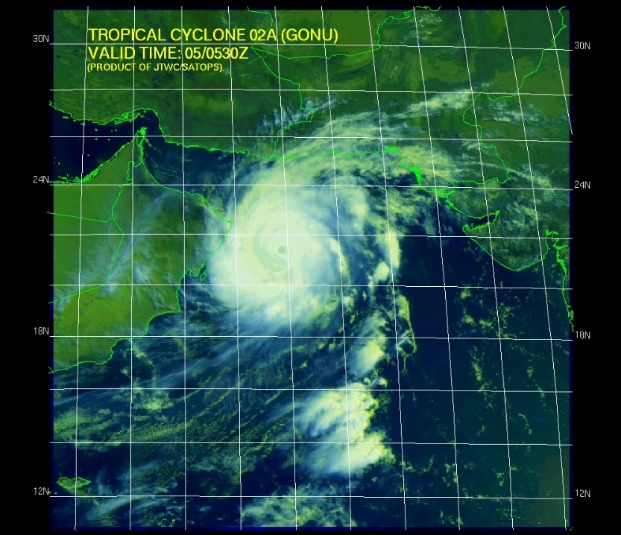 | Figure 2. Satellite image of Cyclone Gonu at 5:30 on 5 June 2007 (image from the Joint Typhoon Warning Center (JTWC)) |
 and
and  denote the wind speed and air pressure, respectively:
denote the wind speed and air pressure, respectively: | (1) |
 | (2) |
 | (3) |
 denotes neutral air pressure,
denotes neutral air pressure,  is pressure at the center of hurricane,
is pressure at the center of hurricane,  is the radius of maximum wind, r is the radial distance from the center of the hurricane, f is Coriolis parameter, and
is the radius of maximum wind, r is the radial distance from the center of the hurricane, f is Coriolis parameter, and  is air density. The cyclone generation module based on this formulation has been incorporated in the Mike 21 model ([20]) and was used for generating Gonu’s wind fields in the present study. Allahdadi et al [17] successfully used this approach to evaluate Gonu’s wind fields that was used for modeling of the waves generated by Gonu. Snapshots of the model-generated wind fields when the eye was located off the tip of Oman (Figure 3a) and in the Gulf of Oman midway between Oman and the Makran coast (Figure 3b) show that cyclone wind fields caused easterly to southeasterly wind in Chabahar Bay.
is air density. The cyclone generation module based on this formulation has been incorporated in the Mike 21 model ([20]) and was used for generating Gonu’s wind fields in the present study. Allahdadi et al [17] successfully used this approach to evaluate Gonu’s wind fields that was used for modeling of the waves generated by Gonu. Snapshots of the model-generated wind fields when the eye was located off the tip of Oman (Figure 3a) and in the Gulf of Oman midway between Oman and the Makran coast (Figure 3b) show that cyclone wind fields caused easterly to southeasterly wind in Chabahar Bay. | Figure 3. Snapshots of model-generated wind fields for Cyclone Gonu at (a) 18:00 on 5 June 2007 and (b) 11:00 on 6 June 2007. Red circles show the location of Chabahar Bay |
4. Field Data Analysis
- Water level at stations AW1, AW2, and AW3 was measured with frequency of 2 Hz using pressures sensors installed on ADCP instruments. At TG1, an RBR instrument was used with recording frequency of 1 Hz. Since the measurements were part of a year-long record in Chabahar Bay, water level data are available for before, during, and after Gonu. The Gulf of Oman, including Chabahar Bay, is characterized by relatively strong tides with average tidal range of about 2 m and a semi-diurnal time variation with period of about 12.4 hours ([21]). Figure 4 shows a month-long time series of water level data from station AW1 during April 2007; two months before Gonu occurred. During this time fair weather conditions prevailed over the northern Gulf of Oman.
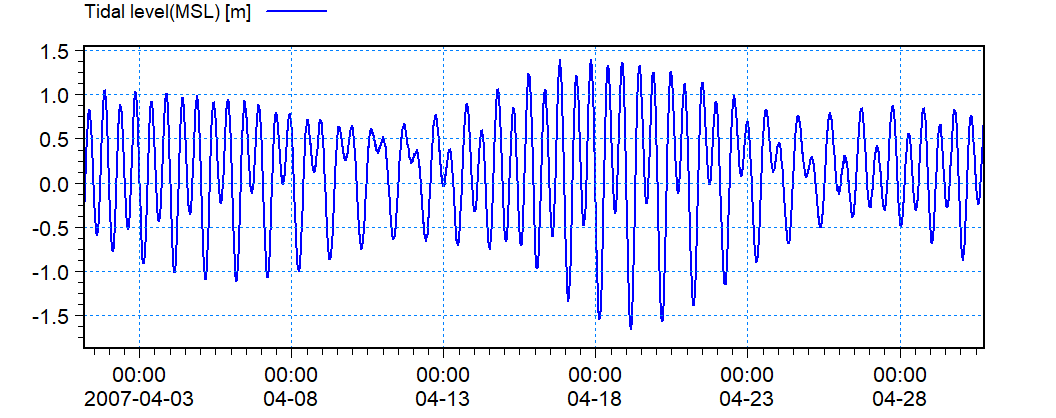 | Figure 4. Variations of measured tidal level at station AW1 during April 2007 |
 | Figure 6. Time series comparison of deduced storm surge from measurements at the four stations in Chabahar Bay |
5. Discussion
- During extreme atmospheric events like cyclones, two mechanisms contribute to water level change in impacted regions: changes in atmospheric pressure and the effect of wind friction on the water surface.These two mechanisms producing storm surge in Chabahar Bay during Cyclone Gonu are discussed here.
5.1. Effect of Atmospheric Pressure Change
- Cyclones are associated with significant decreases in atmospheric pressure, especially close to the cyclone’s eye. While neutral atmospheric pressure (in the absence of a cyclone) is of the order of 1010 mbar, pressure at the center may drop to as low as 900 - 920 mbar ([23]). This extreme low pressure system significantly affects the atmospheric pressure of the surrounding areas. This negative atmospheric pressure itself causes the sea level to rise. Time variations of atmospheric pressure at the center of Cyclone Gonu, as obtained from JTWC, show that lowest central pressure of 92000 Pa (920 mbar) occurred when Gonu was approaching the tip of Oman. While Gonu was traversing the Gulf of Oman (6 - 7 June), the recorded central pressure was 97000 Pa (970 mbar). The maximum storm surge at the four stations in the Chabahar Bay occurred towards the end of this period.Elevation in sea level as a result of a drop in the neutral atmospheric pressure can be easily estimated by considering the pressure P at the surface of a fluid column with density
 and depth h in a static equilibrium:
and depth h in a static equilibrium: | (4) |
 | (5) |
 is the change in pressure,
is the change in pressure,  is the corresponding change in water depth, and
is the corresponding change in water depth, and  , the acceleration due to gravity. By considering
, the acceleration due to gravity. By considering  mbar, and
mbar, and  ,
,  is approximately 0.01 m. Thus at a given location, 1 mbar change of atmospheric pressure will change the sea surface by as much as 0.01 m ([26]).During the passage of Cyclone Gonu, atmospheric pressure over the Arabian Sea and Gulf of Oman substantially decreased from neutral air pressure (Figure 8). During this time, atmospheric pressure over the Gulf of Oman and along the Iranian coasts decreased to about 97500 Pa (975 mbar). Over Chabahar Bay, the pressures on 5 and 7 June were 980 and 975 mbar, respectively. For the regions far from the cyclone’s effect, the pressure was about 1005 mbar, which was assumed to be the neutral air pressure for the Gulf of Oman and northern Arabian Sea. The 30 mbar pressure drop during the cyclone caused a 0.3 meter storm surge in Chabahar Bay. Of the maximum measured storm surge of 0.35 to 0.38 m, the remainder (0.05 – 0.08 m) would be due to wind shear.
is approximately 0.01 m. Thus at a given location, 1 mbar change of atmospheric pressure will change the sea surface by as much as 0.01 m ([26]).During the passage of Cyclone Gonu, atmospheric pressure over the Arabian Sea and Gulf of Oman substantially decreased from neutral air pressure (Figure 8). During this time, atmospheric pressure over the Gulf of Oman and along the Iranian coasts decreased to about 97500 Pa (975 mbar). Over Chabahar Bay, the pressures on 5 and 7 June were 980 and 975 mbar, respectively. For the regions far from the cyclone’s effect, the pressure was about 1005 mbar, which was assumed to be the neutral air pressure for the Gulf of Oman and northern Arabian Sea. The 30 mbar pressure drop during the cyclone caused a 0.3 meter storm surge in Chabahar Bay. Of the maximum measured storm surge of 0.35 to 0.38 m, the remainder (0.05 – 0.08 m) would be due to wind shear.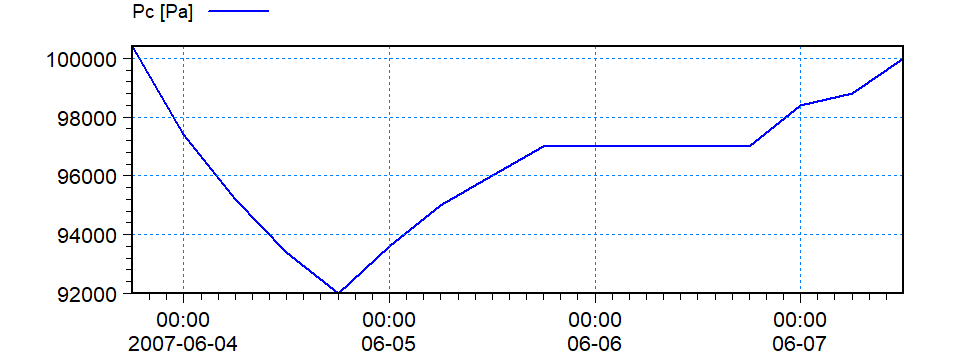 | Figure 7. Time variations of atmospheric pressure, in Pascal (mbar*100), at the center of Cyclone Gonu |
5.2. Effect of Wind Friction
- Intense wind speed produced by a cyclone can pile up water against a land boundary through frictional coupling at the air-sea boundary. Specifically, over the shallow inner shelf waters and for the regions closer to the center of the cyclone, wind shear can be the major contributor in storm surge generation during a hurricane ([8]). Numerical models are extensively used for simulating the storm surge directly induced by the cyclone winds ([4], [8], and [9]). However, based on analyses of field data and pressure fields, only a small part of the maximum storm surge can be attributed to the direct effect of storm winds. To elaborate more on the wind-induced storm surge in Chabahar, an analytical model with some simplifications of the equations of motion was used to estimate the wind-induced storm surge in Chabahar Bay. A one-dimensional form of the equation of motion in a non-rotational system and unbound sea were assumed ([24]). By assuming an equilibrium condition, the differential equation for the free surface slope under the effect of wind shear is represented as:
 | (6) |
 is the density of air,
is the density of air,  is the density of water,
is the density of water,  is the wind stress coefficient which is assumed to be
is the wind stress coefficient which is assumed to be  , V is the wind speed, and H is the static water depth. For a specific wind event at a specific time, the equation for storm surge induced by wind is:
, V is the wind speed, and H is the static water depth. For a specific wind event at a specific time, the equation for storm surge induced by wind is: | (7) |
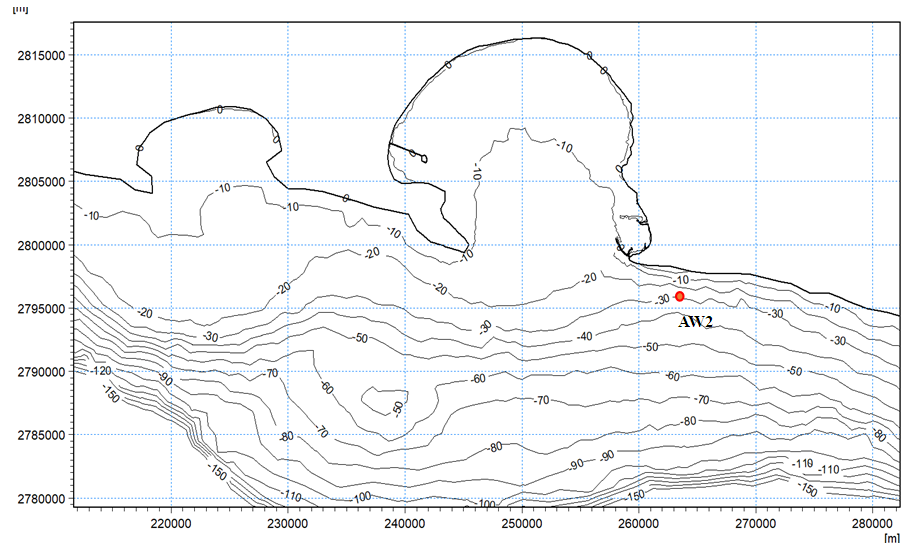 | Figure 9. Water depths in and near Chabahar Bay. Station AW2 is marked. Coordinates are based on UTM 61 map projection |
6. Summary and Conclusions
- In this paper, the effect of tropical Cyclone Gonu on water level variations in Chabahar Bay on the northern coasts of the Gulf of Oman was investigated by examining measured water level at several stations. Gonu travelled the northern Arabian Sean and Gulf of Oman on a track relatively far from Chabahar Bay and at its closest location, the eye was about 200 km away from the Bay. This large distance, along with the narrow continental shelf outside the bay and the direction of cyclone’s movement, significantly decreased the effect of direct wind shear on water level rise in Chabahar. Out of a 0.4 meter maximum sea level rise in Chabahar during Gonu, 0.3 meter was attributed to the atmospheric pressure drop which is 75% of water level rise. An analytical model based on simplified equations of motion showed a maximum wind shear-induced surge of about 0.1 m, in agreement with the results from data analysis and pressure maps. Out of the three factors that contributed to the small storm surge in Chabahar Bay, shelf bathymetry and slope can play key roles in the height of sea level rise during a cyclone. A similar steep bed slope caused a relatively small storm surge even in the vicinity of the cyclone track along the Oman shoreline (maximum storm surge of 1.5 m). In an extreme case, a wide shelf and shallow bathymetry contributed to storm surge as high as 9 m during Hurricane Katrina. However, it should be noted that the amount of wind-induced storm surge also depends on the track and forward speed of the storm. A slow-moving storm over a coastal area can produce large storm surges regardless of the shelf bathymetry. Studying the contribution of coastally trapped waves (Kelvin waves) was not in the scope of this study. However, these waves can negatively or positively interact with cyclone-generated storm surge depending on the direction of storm surge propagation from the cyclone center. This would benefit from further study.
ACKNOWLEDGEMENTS
- This research was supported by the Iranian Port and Maritime Organization, who provided the field data. N.F.T Company is acknowledged for providing the license for MIKE 21. Manuscript edits by Jennifer Warrillow are sincerely appreciated.
 Abstract
Abstract Reference
Reference Full-Text PDF
Full-Text PDF Full-text HTML
Full-text HTML